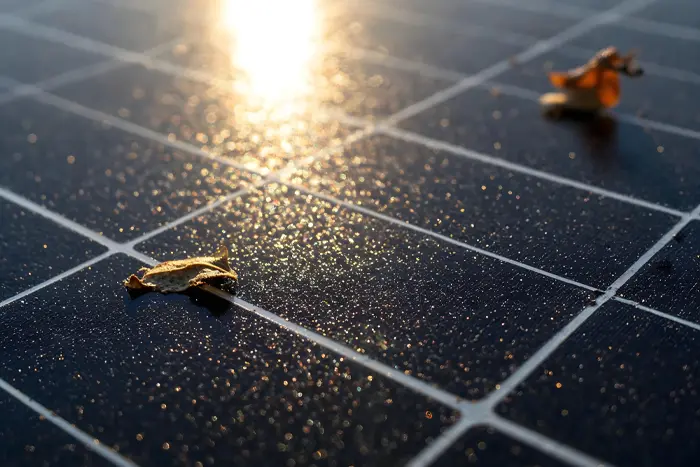The monsoon brings relief, green fields, and—if you’re a solar owner—plenty of questions. A common belief persists: “Why pay for cleaning when the rain will do it?” At first glance rain seems like nature’s car wash for PV arrays, but the reality is more complex. For property owners and installers alike, relying on rain alone can reduce system performance, create maintenance problems, and even void warranties. In this article Green Clean explains why professional cleaning is necessary, how monsoon weather actually interacts with solar modules, and what a proper cleaning program looks like — explained step-by-step so you can use these sections as a blueprint for content or communication.
Why the “Rain Cleans Everything” Myth Persists
Many people assume rain removes all surface dirt because panels look visibly cleaner after a downpour. That visible rinse fuels the belief that nature will handle maintenance for free.
Step-by-step to write this section:
Open with a relatable anecdote about post-rain sparkle.
Explain the intuitive appeal (saves money, effort).
Transition to the idea that visible cleanliness does not equal optimal performance.
What Rain Actually Does to Solar Panels
Rain can remove loose dust and light surface grime, but it leaves behind dissolved minerals, sticky residues, pollen, and pollution particulates. In many regions monsoon rains carry dust to panels as water evaporates, creating water spots and mineral deposits (hard water staining). Also, partial rinsing—where water flows across panels unevenly—can create streaks that reduce light transmission. Organic matter such as bird droppings and pollen is usually unaffected or becomes more bonded to the glass when wet, making later removal harder.
Step-by-step to write this section:
Describe common residues left after rain (minerals, pollen, bird droppings).
Explain how evaporation leads to spots and streaks.
Add a sentence on how these residues affect light transmission and module performance.
The Hidden Performance Cost of “Letting It Rain”
Soiling that remains after rain reduces the sunlight reaching cells and raises module temperature, both of which lower power output. Even moderate soiling across large systems compounds into meaningful energy loss over weeks and months. For commercial or agricultural installations where margins matter, lost generation quickly outweighs the small savings from skipping professional cleaning. There are also secondary costs: blocked drainage, accelerated edge-seal corrosion, and the potential for warranty complications if damage is attributable to neglect.
Step-by-step to write this section:
State the practical consequence (reduced energy yield).
Mention secondary maintenance and warranty risks.
Close with a business-minded line about ROI and operating margins.
Why Professional Cleaning Outperforms Rain
Professional cleaning uses purified or deionized water, controlled rinsing, and gentle mechanical action designed for PV glass and frames. Technicians inspect module mounting, electrical junctions, and seals so problems are caught early. Tools and methods (soft brushes, low-pressure water, squeegees, or approved robotic cleaners) remove mineral deposits, biofilm, and sticky residues that rain leaves behind — without scratching or stressing panels. A proper clean also includes visual and electrical checks, so you’re not just improving optics but verifying system health.
Step-by-step to write this section:
List standard professional cleaning tools and why they matter (deionized water, soft brushes).
Explain the added value of inspection and testing.
Note the safety and warranty compliance advantages.
Green Clean’s Step-by-Step Professional Cleaning Process
Green Clean follows an industry-conscious workflow designed to maximize safety, preserve module integrity, and restore peak performance:
Pre-clean inspection — document soiling levels, check for visible damage, and test baseline production.
Site preparation & safety setup — secure access, use fall protection, and isolate the array electrically where required.
Gentle cleaning with purified water — apply deionized water and soft nylon brushes or approved robotic methods to avoid abrasion.
Targeted spot treatment — remove bird droppings, sap, and mineral stains with approved solutions safe for PV glass.
Rinse and dry — ensure no streaks or residue remain; perform a controlled rinse and squeegee where appropriate.
Post-clean performance check — compare production data to baseline and log improvements; deliver a report with photos and recommendations.
Step-by-step to write this section:
For each numbered step, write one sentence describing why it’s done and what benefit the customer receives.
Include a note about documentation (photos, before-and-after readings).
When to Schedule Professional Cleanings (Practical Guidance)
Frequency depends on local climate, tilt, and surrounding environment. Typical triggers for a professional visit include:
Visible soiling or streaking after rain events.
Seasonal pollen or post-harvest dust accumulation.
Nearby construction, heavy traffic corridors, or bird congregations.
Decline in generation data or a sudden drop in daily yield.
Green Clean recommends a condition-based schedule: baseline quarterly inspections with responsive cleanings after high-soil events. This keeps operating costs predictable while protecting energy production.
Step-by-step to write this section:
Present a simple decision rule (inspect quarterly; clean when soiling exceeds X or after specific events).
Give local/seasonal examples (monsoon season, harvest dust, etc.).
Practical Tips for Owners Between Professional Visits
Don’t attempt high-pressure washing or abrasive cleaners — they damage coatings.
Keep large debris, leaves, and nests cleared safely from array surroundings.
Monitor production data; a steady drop often indicates soiling.
If you must rinse panels, use deionized water only and work from the top down with soft tools.
Always prioritize safety — hire professionals for roof access or large arrays.
Step-by-step to write this section:
Short, actionable bullets for non-technical readers.
End with a safety reminder.
Conclusion — Rain Helps, But It’s Not a Replacement
Monsoon rain is a welcome natural event, but it is not a reliable substitute for professional solar cleaning. Residues, deposits, and the adhesive effects of wetting can leave arrays worse off in the days after a storm. For sustained performance, predictable yield, and long-term asset protection, a planned professional maintenance program is essential. Green Clean delivers targeted cleaning, inspection, and reporting so your system returns to its designed output — safely and efficiently.


